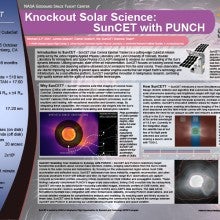Knockout Solar Science: SunCET with PUNCH
Michael
Kirk
NASA Goddard Space Flight Center
James Mason JHU/Applied Physics Laboratory
Dan Seaton Southwest Research Institute
Matthew West Southwest Research Institute
Andrew Jones CU/Laboratory for Atmospheric and Space Physics
Joan Burkepile High Altitude Observatory
Phil Chamberlin CU/Laboratory for Atmospheric and Space Physics
Robin Colaninno Naval Research Laboratory
Karin Dissauer Northwest Research Associates
Frank Eparvier CU/Laboratory for Atmospheric and Space Physics
Yuhong Fan High Altitude Observatory
Sarah Gibson High Altitude Observatory
Christina Kay JHU/Applied Physics Laboratory
Dean Pesnell NASA Goddard Space Flight Center
Dan Seaton Southwest Research Institute
Matthew West Southwest Research Institute
Andrew Jones CU/Laboratory for Atmospheric and Space Physics
Joan Burkepile High Altitude Observatory
Phil Chamberlin CU/Laboratory for Atmospheric and Space Physics
Robin Colaninno Naval Research Laboratory
Karin Dissauer Northwest Research Associates
Frank Eparvier CU/Laboratory for Atmospheric and Space Physics
Yuhong Fan High Altitude Observatory
Sarah Gibson High Altitude Observatory
Christina Kay JHU/Applied Physics Laboratory
Dean Pesnell NASA Goddard Space Flight Center
Oral and Poster
The Sun Coronal Eruption Tracker (SunCET) CubeSat and the PUNCH (Polarimeter to UNify the Corona and Heliosphere) mission are poised to revolutionize our understanding of solar and heliospheric physics through a uniquely synergistic observational strategy. Launching in late-2025, SunCET will capture the initiation and early development of solar eruptions—such as coronal mass ejections (CMEs), jets, and flares—using a broad EUV passband covering plasma temperatures from approximately 0.8–2 million Kelvin. Its high-dynamic range observations will span from the solar disk center out to about 5.6 solar radii (R_sun) equatorially, providing crucial insights into the mechanisms driving eruption onset and acceleration. Meanwhile, PUNCH is designed to observe the extended solar corona and heliosphere at larger scales, with the Narrow Field Imager (NFI) capturing structures between 5.4–32 R_sun. By bridging SunCET’s detailed views of eruption genesis with PUNCH’s wide-field imaging of the corona and solar wind, these two missions will offer a comprehensive perspective on how impulsive solar events and solar wind structures evolve and propagate from the lower corona into interplanetary space. Through coordinated data products and observations, SunCET and PUNCH will provide the critical linkage needed for accurate initial and boundary conditions in models of eruptive events, ultimately advancing our capability to understand and forecast space weather phenomena.

Poster PDF
Presentation file
YouTube link
Meeting homepage